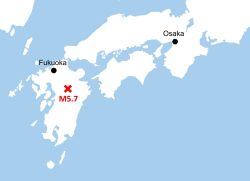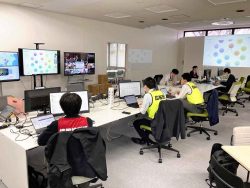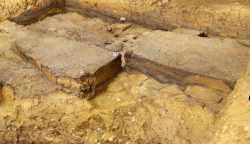‘Nowhere in Gaza is Safe’ for Palestinians in Rafah; Getting Food, Water Also Becoming Increasingly Difficult

A Palestinian woman weeps at a hospital in Rafah, southern Gaza Strip, on Monday after her son died in an Israeli airstrike.
19:44 JST, May 31, 2024
The intensifying Israeli military offensive in Rafah, a southern city in the Palestinian territory of Gaza, has left displaced Palestinians who had been sheltering there in even more of a predicament as food supplies and safe areas become scarce.
Many Palestinians had fled to Rafah after the Israeli military previously designated the area as a “safe zone.” However, acquiring food there has become increasingly difficult since Israeli forces launched an attack on the city and took control of the Rafah border checkpoint in early May, blocking the flow of relief supplies.
After a massive explosion rocked Rafah just before 10 p.m. on Sunday, Majid Attar, a 56-year-old man who had fled to the area from the northern Gaza town of Beit Lahiya, ran out of his tent pitched near a U.N. facility. Attar saw flames rising several meters into the air nearby, and the fire spread quickly.
The airstrike hit a neighborhood adjacent to Al-Mawasi, a coastal district the Israeli military had designated as a “humanitarian zone.” The area was packed with basic tents erected by displaced Palestinians.
Forty-five bodies were found in the neighborhood the following morning, including five of Attar’s relatives who had fled with him from Beit Lahiya.
Since leaving his home in October last year, Attar and his family had moved around seeking shelter in places such as Deir al-Balah in central Gaza and further south in Rafah. His family decided to stay in the neighborhood because they had heard it was a safer part of Rafah after moving around in the city.
“This is an absolute slaughter,” Attar said angrily to The Yomiuri Shimbun. “Enough is enough.”
In May, the Israeli military warned people in eastern Rafah to evacuate to coastal areas such as Al-Mawasi. Israel then began its offensive.
Al-Mawasi largely consists of sandy dunes, and Hamas, the Islamist militant group that effectively rules Gaza, reportedly has no underground tunnels there. Therefore, it has been designated as an area to which Palestinians should evacuate for their safety.
According to the U.N. Relief and Works Agency for Palestine Refugees in the Near East (UNRWA), about 945,000 people have been displaced from Rafah since the Israeli military operation there began.
1 meal a day

Nahla Taaima describes the hardships of daily life in Rafah.
The Rafah crossing has been closed since Israel seized control of the checkpoint, and deliveries of much-needed relief supplies has been disrupted. The situation in Rafah is chaotic as people seek shelter, and getting food and water there is becoming increasingly difficult.
Nahla Taaima and her family of 12 moved to Al-Mawasi from Khan Younis in the southern Gaza Strip when Israel launched a ground offensive there in December. The family now lives in a tent and has no money, so they rely on aid supplies for food. Taaima’s family uses what little wheat is left to make bread, which they eat once a day along with some canned beans. However, their food will soon run out. A 9-month-old baby girl in the family appears to be malnourished.
“The last time we ate meat was in November last year,” Taaima, 51, said with a sigh. “How are we supposed to survive without eating nutritious meals?”
Ridwan Ahmed, 55, and his family of 19 have been staying in Al-Mawasi since leaving their home in Gaza City in November. An airstrike on Sunday night hit an area a few hundred meters away and terrified the children.
“Nowhere in Gaza is safe,” Ahmed said weakly. “I don’t know where we should flee to.”

"Society" POPULAR ARTICLE
-

M4.9 Earthquake Hits Tokyo, Neighboring Prefectures
-

M7.5 Earthquake Hits Northern Japan; Tsunami Waves Observed in Hokkaido, Aomori and Iwate Prefectures
-

Tsukiji Market Urges Tourists to Avoid Visiting in Year-End
-

Israeli Tourists Refused Accommodation at Hotel in Japan’s Nagano Pref., Prompting Protest by Israeli Embassy and Probe by Prefecture
-

M5.7 Earthquake Hits Japan’s Kumamoto Pref., Measuring Upper 5 Intensity, No Tsunami Expected
JN ACCESS RANKING
-

Keidanren Chairman Yoshinobu Tsutsui Visits Kashiwazaki-Kariwa Nuclear Power Plant; Inspects New Emergency Safety System
-

Imports of Rare Earths from China Facing Delays, May Be Caused by Deterioration of Japan-China Relations
-

University of Tokyo Professor Discusses Japanese Economic Security in Interview Ahead of Forum
-

Japan Pulls out of Vietnam Nuclear Project, Complicating Hanoi’s Power Plans
-

Govt Aims to Expand NISA Program Lineup, Abolish Age Restriction






















